《表示地点方位的介词——“前后上下”的表达方法》进阶练习(一)-1-2
- 格式:docx
- 大小:13.53 KB
- 文档页数:2
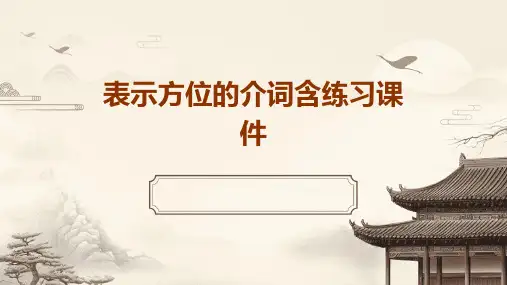
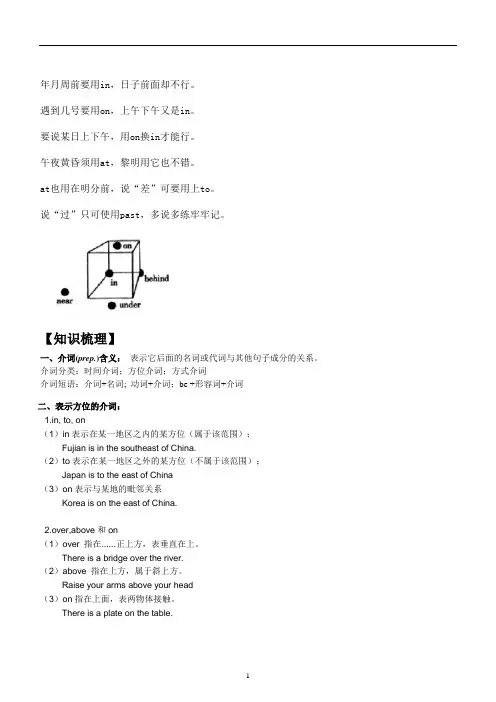
年月周前要用in,日子前面却不行。
遇到几号要用on,上午下午又是in。
要说某日上下午,用on换in才能行。
午夜黄昏须用at,黎明用它也不错。
at也用在明分前,说“差”可要用上to。
说“过”只可使用past,多说多练牢牢记。
【知识梳理】一、介词(prep.)含义:表示它后面的名词或代词与其他句子成分的关系。
介词分类:时间介词;方位介词;方式介词介词短语:介词+名词; 动词+介词;be +形容词+介词二、表示方位的介词:1.in, to, on(1)in表示在某一地区之内的某方位(属于该范围);Fujian is in the southeast of China.(2)to表示在某一地区之外的某方位(不属于该范围);Japan is to the east of China(3)on表示与某地的毗邻关系Korea is on the east of China.2.over,above和on(1)over 指在......正上方,表垂直在上。
There is a bridge over the river.(2)above 指在上方,属于斜上方。
Raise your arms above your head(3)on指在上面,表两物体接触。
There is a plate on the table.3.at,in和on的用法区别(1)at 表示较小的地方。
at the bus stop, at home(2)in 表示较大的地方。
in China, in the world(3)on 表示在一个平面上。
on the table4.(1) in front of在......之前(范围外)。
There are some trees in front of the classroom(2) in the front of表示“在......的前部”(范围内)Our teacher usually sits in the front of the classroom.(3)before所表示的位置关系和in front of 通用,表示“在......前”,“在......面前”5.below,under(1)below表示“在下方或位置低于......”,不一定有垂直在下之意;(2) under表示“在......正下方”。
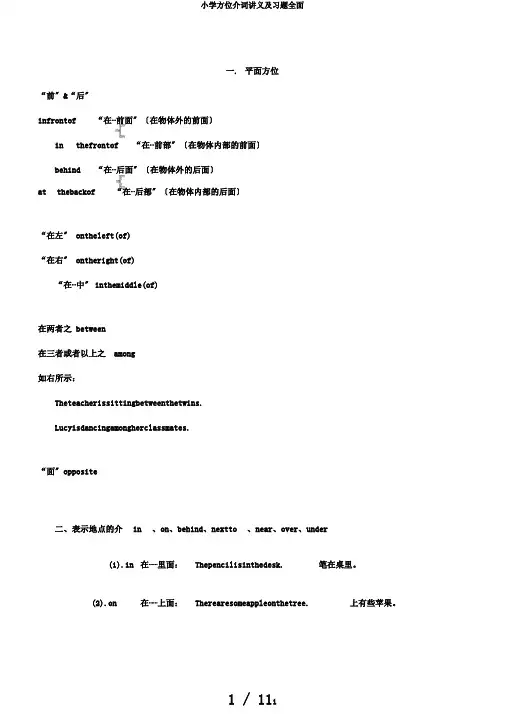
一. 平面方位“前〞&“后〞infrontof “在⋯前面〞〔在物体外的前面〕in thefrontof “在⋯前部〞〔在物体内部的前面〕behind “在⋯后面〞〔在物体外的后面〕at thebackof “在⋯后部〞〔在物体内部的后面〕“在左〞 ontheleft(of)“在右〞 ontheright(of)“在⋯中〞inthemiddle(of)在两者之 between在三者或者以上之among如右所示:Theteacherissittingbetweenthetwins.Lucyisdancingamongherclassmates.“面〞opposite二、表示地点的介in 、on、behind、nextto 、near、over、under(1).in 在⋯⋯里面:Thepencilisinthedesk. 笔在桌里。
(2).on 在⋯⋯上面:Therearesomeappleonthetree. 上有些苹果。
(3).under 在⋯⋯下面/正下方:What'sunderyourdesk 你桌底下是什么(4).over 在⋯⋯正上方:Thereisashelfoverthetable. 桌子上方有一个架。
(5).above 在⋯⋯斜上方:Raiseyourarmsaboveyourhead.(6).below 在⋯⋯斜下方:Herskirtcamebelowherknees.(7).behind 在⋯⋯之后:Thereisa bikebehind the tree. 后有一自行。
(8).nextto 在⋯⋯旁:Thereisacaf énexttothebarber's.理店隔壁是一家咖啡。
(9).near 在⋯⋯附近:Mybedisnearthewindow. 我的床在窗旁。
(10).by 在⋯⋯旁:Hewassittingbythewindow.第一:over,above 和on的用法1〕over指在⋯的正上方,表示垂直在上。
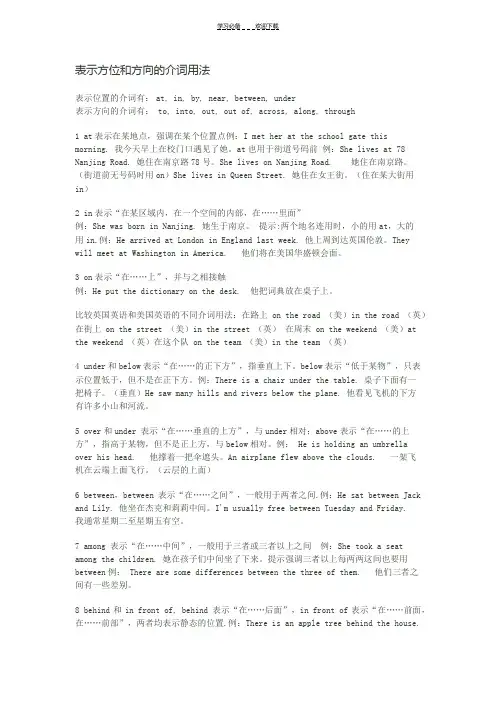
表示方位和方向的介词用法表示位置的介词有:at, in, by, near, between, under表示方向的介词有: to, into, out, out of, across, along, through1 at表示在某地点,强调在某个位置点例:I met her at the school gate this morning. 我今天早上在校门口遇见了她。
at也用于街道号码前例:She lives at 78 Nanjing Road. 她住在南京路78号。
She lives on Nanjing Road. 她住在南京路。
(街道前无号码时用on)She lives in Queen Street. 她住在女王街。
(住在某大街用in)2 in表示“在某区域内,在一个空间的内部,在……里面”例:She was born in Nanjing. 她生于南京。
提示:两个地名连用时,小的用at,大的用in.例:He arrived at London in England last week. 他上周到达英国伦敦。
Theywill meet at Washington in America. 他们将在美国华盛顿会面。
3 on表示“在……上”,并与之相接触例:He put the dictionary on the desk. 他把词典放在桌子上。
比较英国英语和美国英语的不同介词用法:在路上 on the road (美)in the road (英)在街上 on the street (美)in the street (英)在周末 on the weekend (美)at the weekend (英)在这个队 on the team (美)in the team (英)4 under和below表示“在……的正下方”,指垂直上下。
below表示“低于某物”,只表示位置低于,但不是在正下方。
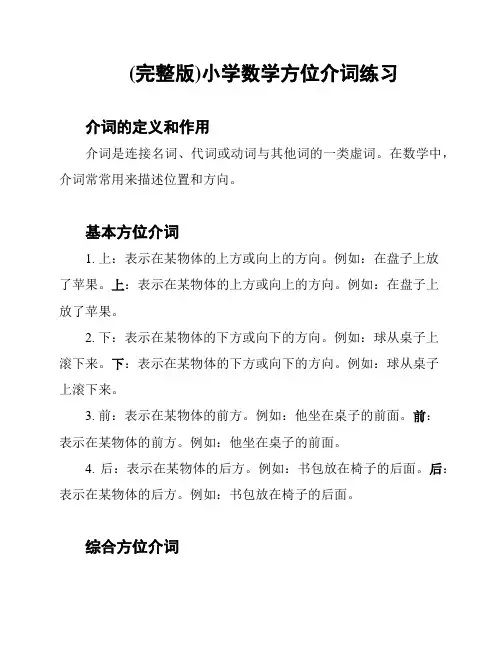
(完整版)小学数学方位介词练习介词的定义和作用介词是连接名词、代词或动词与其他词的一类虚词。
在数学中,介词常常用来描述位置和方向。
基本方位介词1. 上:表示在某物体的上方或向上的方向。
例如:在盘子上放了苹果。
上:表示在某物体的上方或向上的方向。
例如:在盘子上放了苹果。
2. 下:表示在某物体的下方或向下的方向。
例如:球从桌子上滚下来。
下:表示在某物体的下方或向下的方向。
例如:球从桌子上滚下来。
3. 前:表示在某物体的前方。
例如:他坐在桌子的前面。
前:表示在某物体的前方。
例如:他坐在桌子的前面。
4. 后:表示在某物体的后方。
例如:书包放在椅子的后面。
后:表示在某物体的后方。
例如:书包放在椅子的后面。
综合方位介词1. 左:表示在某物体的左边。
例如:往左转。
左:表示在某物体的左边。
例如:往左转。
2. 右:表示在某物体的右边。
例如:往右走。
右:表示在某物体的右边。
例如:往右走。
3. 中间:表示在某物体的中间位置。
例如:电视机放在房间的中间。
中间:表示在某物体的中间位置。
例如:电视机放在房间的中间。
4. 旁边:表示在某物体的侧边位置。
例如:他坐在我旁边。
旁边:表示在某物体的侧边位置。
例如:他坐在我旁边。
练题1. 球从桌子上滚到地下,请在黑板上画出球的位置。
上滚到地下,请在黑板上画出球的位置。
2. 盒子在椅子的前面,书包放在盒子的后面,请在纸上写出书包的位置。
前面,书包放在盒子的后面,请在纸上写出书包的位置。
3. 你的左手在纸的左边,右手在纸的右边,请在纸上划出你的位置。
左边,右手在纸的右边,请在纸上划出你的位置。
4. 小猫在花丛的中间,小狗在小猫的旁边,请在草地上画出小猫和小狗的位置。
总结通过本次练习,我们学习了数学中常用的方位介词,包括基本方位介词和综合方位介词。
方位介词对于描述位置和方向非常重要,希望大家通过练习能够掌握它们的用法。
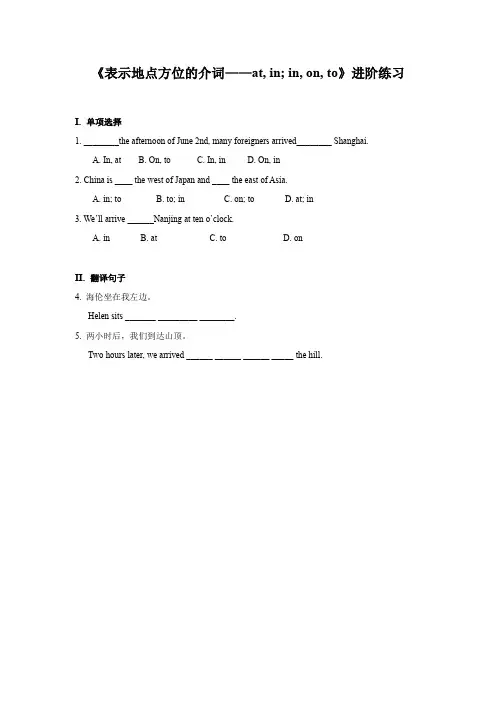
《表示地点方位的介词——at, in; in, on, to》进阶练习I. 单项选择1. ________the afternoon of June 2nd, many foreigners arrived________ Shanghai.A. In, atB. On, toC. In, inD. On, in2. China is ____ the west of Japan and ____ the east of Asia.A. in; toB. to; inC. on; toD. at; in3. We’ll arrive ______Nanjing at ten o’clock.A. inB. atC. toD. onII. 翻译句子4. 海伦坐在我左边。
Helen sits _______ _________ ________.5. 两小时后,我们到达山顶。
Two hours later, we arrived ______ ______ ______ _____ the hill.参考答案I. 1. D 2. B 3. AII. 4. on my left 5. at the top of解析1. 句意为:六月二日下午,许多外国人到达上海。
在英语中,在具体某一天时间前应用介词on。
此外,arrive是不及物动词,到达某地,需要接at或in 。
arrive at 是指到达的地方范围比较小,比如station, cinema, park等小地方;arrive in是指到达的地方范围比较大,比如Beijing等大地方。
故选D。
2. in,在……范围之内;to,在……范围之外;on,表示两地接壤,根据句意:中国在日本的西面,亚洲的东部。
可知B项是正确的,故选B。
3. 表示“到达”用arrive in或arrive at, in后接大地方,at后接小地方。
南京是一个大城市,故选A。
4. 坐在某人左边:sit on the left of sb. / sit on one’s left 。
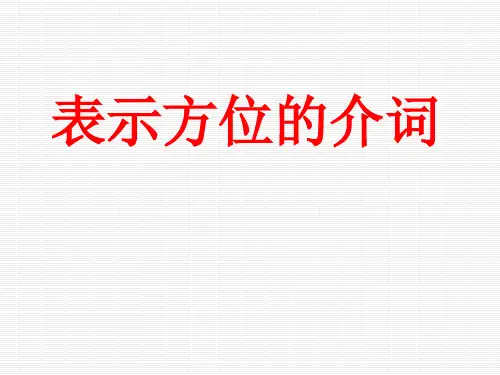
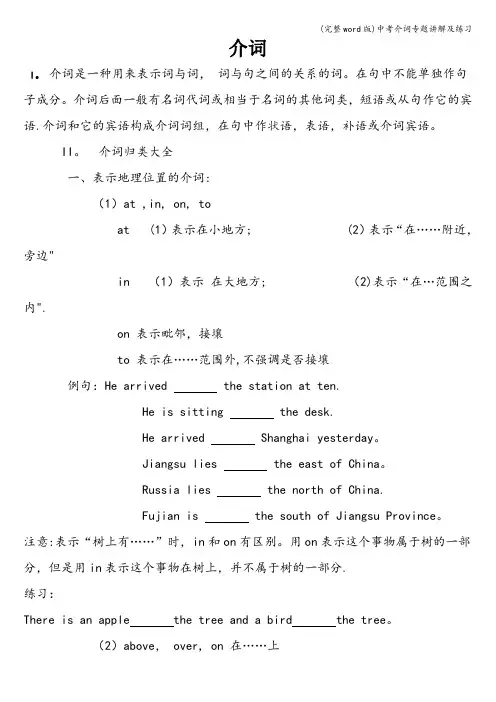
介词I。
介词是一种用来表示词与词,词与句之间的关系的词。
在句中不能单独作句子成分。
介词后面一般有名词代词或相当于名词的其他词类,短语或从句作它的宾语.介词和它的宾语构成介词词组,在句中作状语,表语,补语或介词宾语。
II。
介词归类大全一、表示地理位置的介词:(1)at ,in, on, toat (1)表示在小地方; (2)表示“在……附近,旁边"in (1)表示在大地方; (2)表示“在…范围之内".on 表示毗邻,接壤to 表示在……范围外,不强调是否接壤例句:He arrived the station at ten.He is sitting the desk.He arrived Shanghai yesterday。
Jiangsu lies the east of China。
Russia lies the north of China.Fujian is the south of Jiangsu Province。
注意:表示“树上有……”时,in和on有区别。
用on表示这个事物属于树的一部分,但是用in表示这个事物在树上,并不属于树的一部分.练习:There is an apple the tree and a bird the tree。
(2)above, over, on 在……上above 指在……上方,不强调是否垂直,与 below相对;over指垂直的上方,与under相对,但over与物体有一定的空间,不直接接触。
on表示某物体上面并与之接触。
例句:The bird is flying my head。
There is a bridge the river。
He put his watch the desk。
(3)below, under 在……下面under表示在…正下方below表示在……下,不一定在正下方例句 There is a cat the table。
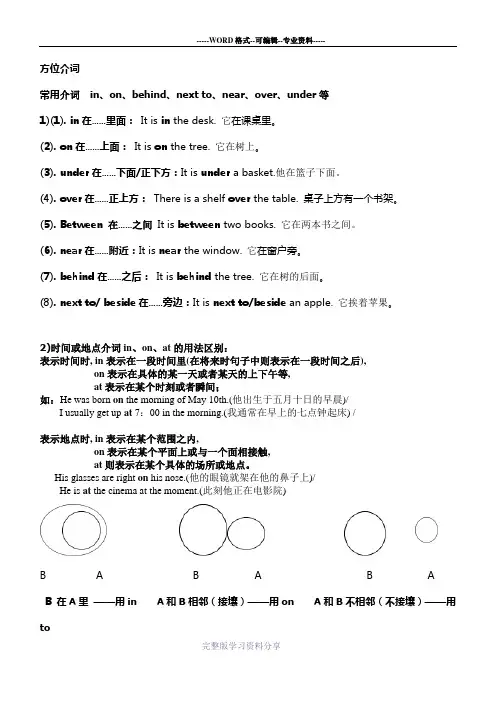
方位介词常用介词in、on、behind、next to、near、over、under等1)(1). in在……里面:It is in the desk.它在课桌里。
(2). on在……上面:It is on the tree.它在树上。
(3). under在……下面/正下方:It is under a basket.他在篮子下面。
(4). over在……正上方:There is a shelf over the table.桌子上方有一个书架。
(5). Between 在……之间It is between two books. 它在两本书之间。
(6). near在……附近:It is near the window. 它在窗户旁。
(7). behind在……之后:It is behind the tree. 它在树的后面。
(8). next to/ beside在……旁边:It is next to/beside an apple. 它挨着苹果。
2)时间或地点介词in、on、at的用法区别:表示时间时, in表示在一段时间里(在将来时句子中则表示在一段时间之后),on表示在具体的某一天或者某天的上下午等,at表示在某个时刻或者瞬间;如:He was born on the morning of May 10th.(他出生于五月十日的早晨)/I usually get up at 7:00 in the morning.(我通常在早上的七点钟起床) /表示地点时, in表示在某个范围之内,on表示在某个平面上或与一个面相接触,at则表示在某个具体的场所或地点。
His glasses are right on his nose.(他的眼镜就架在他的鼻子上)/He is at the cinema at the moment.(此刻他正在电影院)B A B A B AB 在A里——用in A和B相邻(接壤)——用on A和B不相邻(不接壤)——用to3) in front of “在…之前”(范围外)in the front of 表示“在…的前部”(范围内)实战演练1. The United States is ____ the south of Canada and ___ the east of Japan.A. to; inB. on; toC. in; besideD. at; on2 . Japan lies____ the east of China.A. on B/ to C. in D. with3. Jiangsu is___ the east of China, but Japan is ___ the east of China.A. to; inB. in; to .C. on; toD. to; on4. There are some trees_________ the classroomThere is a blackboard ____________ the classroom.A. in front ofB. in the front of5. —Look, there are many apples ______ the tree.—Yes. And a boy is picking apples ______ the tree now.A. in; onB. on; inC. in; inD. on; on6. When did you arrive ______school this morning?A. inB. atC. toD. with。
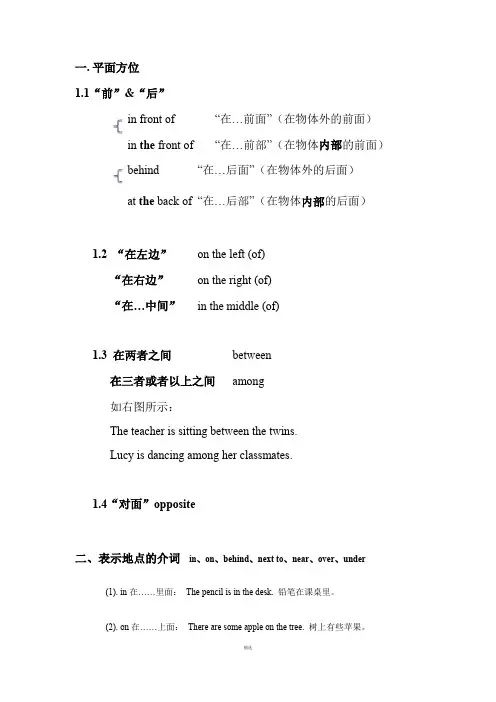
一.平面方位1.1“前”&“后”in front of “在…前面”(在物体外的前面)in the front of “在…前部”(在物体内部的前面)behind“在…后面”(在物体外的后面)at the back of“在…后部”(在物体内部的后面)1.2 “在左边”on the left (of)“在右边”on the right (of)“在…中间”in the middle (of)1.3 在两者之间between在三者或者以上之间among如右图所示:The teacher is sitting between the twins.Lucy is dancing among her classmates.1.4“对面”opposite二、表示地点的介词in、on、behind、next to、near、over、under(1). in在……里面:The pencil is in the desk. 铅笔在课桌里。
(2). on在……上面:There are some apple on the tree. 树上有些苹果。
(3). under在……下面/正下方:What's under your desk? 你书桌底下是什么?(4). over在……正上方:There is a shelf over the table. 桌子上方有一个书架。
(5). above 在……斜上方:Raise your arms above your head.(6). below 在……斜下方:Her skirt came below her knees.(7).behind在……之后:There is a bike behind the tree. 树后有一辆自行车。
(8).next to在……旁边:There is a café next to the barber's. 理发店隔壁是一家咖啡馆。
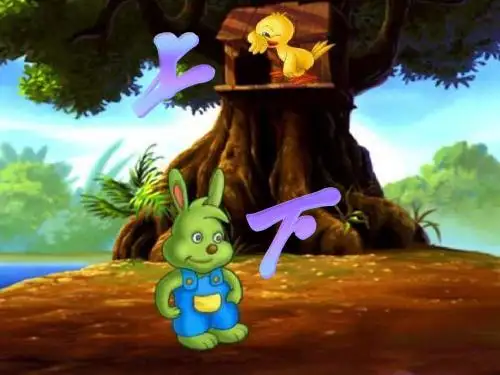
(完整)初中地理七年级方位介词详解及练
习
初中地理七年级方位介词详解及练
介绍
本文档将详细介绍初中地理七年级方位介词的使用方法,并提供相关练。
方位介词
方位介词是用来表示地理位置和方向的词语。
在地理学中,常用的方位介词有以下几个:
1. 在 - 表示某物或某人在什么地方,如:在图书馆、在学校。
2. 在...的上方 - 表示某物在另一个物体的上面,如:在桌子的上方、在山的上方。
3. 在...的下方 - 表示某物在另一个物体的下面,如:在椅子的下方、在河的下方。
4. 在...的左边 - 表示某物在另一个物体的左边,如:在书包的左边、在公园的左边。
5. 在...的右边 - 表示某物在另一个物体的右边,如:在窗户的右边、在湖的右边。
6. 在...的前面 - 表示某物在另一个物体的前面,如:在门的前面、在山的前面。
7. 在...的后面 - 表示某物在另一个物体的后面,如:在梯子的后面、在楼的后面。
练题
请根据以下描述填入合适的方位介词:
1. 我的书包 __学校门口__。
2. 我家楼下有一棵大树,我经常在大树 __玩耍__。
3. 我的书在桌子__下面__。
4. 图书馆__右边__有一个咖啡店。
5. 我住的小区__里面__有一个游泳池。
答案:
1. 在
2. 下面
3. 的左边
4. 的前面
5. 的后面
以上是初中地理七年级方位介词的详解和练习。
希望对你有帮助!。
《表示地点方位的介词——“前后上下”的表达方法》进阶练习I. 单项选择1. Liu Mei is short. So she sits ________the class.A. in front ofB. in the front ofC. on the front ofD. behind2. I live on the top floor of the building, and Andy lives two floors _____ me.A. overB. behindC. belowD. above3. In cold winter, the temperature in Harbin often remains ________zero all day.A. aboveB. belowC. overD. underII. 选词填空4. There are two trees _____ (in front of / in the front of) the house.5. There are four big bridges ______ the Changjiang River. (over/ above)参考答案I. 1. B 2. C 3. BII. 4. in front of 5. over解析1. 由上句Liu Mei is short.可知Liu Mei个子矮,个子矮按照常理应该是坐在班级的前面,在英文里表示在物体内部前面,通常可用in the front of,in front of表示在物体外部的前面,behind表示在某物的后面,选项B符合语境,故选B。
2. 句意:我住在这座楼的顶层,安迪住在我下面两层。
A. over在......上面;B. behind在......后面;C. below在......下面;D. above在......上面。
依据题意,故选C。
《表示地点方位的介词——at, in; in, on, to》进阶练习I. 单项选择1. _____ photo, I’m swimming _____ the pool.A. In second, atB. At second, atC. In the second, atD. In the second, in2. ______ right_____ the first crossing.A. Take; atB. Turn; onC. Turn; inD. Turn; at3. —Can you see an apple tree near the house?—Yes, there are some apples_______ the trees, and some birds are singing ____ it.A. in, onB. on, inC. on, onII. 选词填空4. --Mary, we are _______a trip _______Shanghai this holiday.---Oh, have a good time. (to/ on/in)5. There is a picture ________the wall _____the room. (in/ on/to/ at)参考答案I. 1. D 2. D 3. BII. 4. on,to 5. on,in解析1. 句意:在第二张照片里,我正在游泳池里游泳。
序数词second前加the,in the second photo 在第二张照片里,in the pool在游泳池里。
故选D。
2. 句意:在第一个十字路口右转。
take带走;turn转弯;at在,后跟小地点;in在,后跟大地点。
根据句意可知答案,故选D。
3. on the tree表示长在树上,in the tree 表示其他的东西在树上,故选B。
名师指导:介词用法及练习一、方位介词大阅兵! 表示地点的介词歌诀:里面上面in和on;over, under上下方;in front of前,behind后,at就在某地点上;来自from,朝前to,里面穿过是through;到上面onto,进里面into,我们一定要记住;在旁边beside,附近near,距离远近要明确。
1.under:在……下面(表示位置),和over位置正好相反。
Are they under the chair它们在椅子底下吗2. in front of表示“在……的前面”。
(区分in the front of)如:There are some bikes in front of our classroom.我们的教室前面有些自行车。
3. behind表示“在……后面(表示位置)”,和in front of位置正好相反。
Behind the house there is a tree. 房子后面有一棵树。
4. to表示“到,往(表示方向);给,对(表示接受对象)”。
Could you take it to the classroom你把它拿到教室去好吗?Give it to . 把它交给胡先生。
5. from意为“从……,自……以来,出自……”。
Can you count from one to a hundred你能从一数到一百吗?I’m from China. 我来自中国。
6. through表示“通过、穿过”等,指的是从一个立体空间穿过。
across表示“横过、穿过”则是指从物体表面穿过。
如:He walks through the house.他穿过了这所房子。
She goes across the bridge. 她过了桥。
二、语言要点1. --- Where's my backpack--- It's under the table.--- Where're my books--- They are on the sofa.(在询问物品位置的时候使用Where问句。
欢迎阅读表示地点的介词in、on、behind、next to、near、over、under(1) in在……里面:The pencil is in the desk. 铅笔在课桌里。
(2) on在……上面:There are some apple on the tree. 树上有些苹果。
(3) under在……下面/正下方:What's under your desk? 你书桌底下是什么?(4) over在……正上方:There is a shelf over the table. 桌子上方有一个书架。
(5) above 在……斜上方:Raise your arms above your head.(6) below 在……斜下方:Her skirt came below her knees.(7) behind在……之后:There is a bike behind the tree. 树后有一辆自行车。
A. onB. toC. ofD.in( ) 3 Any man ___ eyes______ his head can see that he's exactly like a rope.A. with; onB. with; inC. on; withD. in; with2) 鸟一类落在树上的,用in; 苹果一类长在树上的,用on( ) 1 There are some birds singing___ the trees.A. inB. onC. atD. from( ) 2 There are so many apples___ that tree.A. in B, on C. at D. from第四组:in /on/ to表示“接壤”B A B A B AB 在A里—用in A和B相邻(接壤)—用on A和B不相邻(不接壤)—用to( ) 1 The United States is ____ the south of Canada and ___ the east of Japan.A. to; in??B. on; to??C. in; beside??D. at; on( ) 2 The man stood____the window, watching the boys playing outside.?A. in??B. by??C. with??D. to( ) 3 Japan lies____ the east of China.A. on??B. to??C. in??D. with1 Tom sits____the classroom while John sits____the room.A. in front of; at back of??B. in the front of; at the back of?C. in front of; at the back of??D. in the front of; at back of2 Lucy sits____ th e third row, ____Jim‘s left.A. on; on??B. in; at??C. at; in??D. in; on3 Jiangsu is___ the east of China, but Japan is ___ the east of China.?A. to; in??B. in; to .??C. on; to??D. to; on4 Don‘t read ____ the sun. It‘s bad ___ your eyes.A. in; to??B. under; for??C. with; to??D. in; on5 The woman____ a blue dress is my teacher.A. in??B. on??C. of??D. at6 ___ research ___ the universe scientists have put a lot of information ___ computers.A. With; over; at??B. On; at; toC. In; about; into??D. For; with; through7 When a piece of ice is taken ____ a warm room, it gets smaller and smaller until ___ the end it disappears completely.A. in; in??B. out of; at??C. into; in??D. to; by练习2:5. I him myself.7. LookA inA forC March,1989D 1989,in March11.We had our breakfast ___a quarter ___sevenA /,toB in,toC at,toD on,to12. It's good manners to wait ___lineA inB onC atD with13. How many English words had you learnt ___last term?A by the end ofB at the end ofC to the end ofD till the end of14. I was born ___the night ___September 15,1978A in,on Bat,on Cat,in Don,of15. It's a bad manner to laugh ___people when they are ___troubleA over,in Bat,in C in,at D at,for16. The people's Republic of China was founded ___1949A withB onC sinceD in17. He arrived _____ Guangzhou ____ noon.A. in; inB. to; atC. in; atD. at; in18. They work _____ a small farm _____ a river.A. on; byB. at; onC. by; onD. in; in19. --When will Mr Black come to Beijing?-- ____ September 5th.A. OnB. ToC. AtD. In20. ____ the night before Christmas Day, parents fill their children’s stockings with small presents.A. Of答案:练习1:练习2:。
人教版一年级数学上册位置《上下前后》分辨重点+课后习题《上下前后》分辨重点1. 认识上、下上是指位置在高处的,与下相对;下是指位置在低处的,与上相对。
2. 判断上、下位置关系的方法:首先确定参照物,再确定所描述的物体是在参照物的上面,还是在参照物的下面。
上、下是两个具有相对关系的方位,两者相互依存,不能单独存在。
不能单独说某物体在上面或下面,应说某物体在另一物体的上面或下面。
重点例子:3. 认识前、后一般面对的方向是前,背对的方向是后。
4. 判断前、后位置关系的方法:以参照物为标准,参照物面向的方向是前,背对的方向是后。
前、后是两个具有相对关系的方位,两者相互依存,不能单独存在。
不能单独说某物体在前面或后面,应说某物体在另一物体的前面或后面。
同一物体相对于不同的参照物,上、下、前、后的位置关系会发生变化。
因此,确定两个以上物体的上、下、前、后位置关系时,要找准参照物,选择的参照物不同,相对的上、下、前、后位置关系会发生变化。
重点例子:人教版一年级上册《上下前后》测试题及答案一.看图找位置。
(24分)(1)小明骑马,小明在马的()面,马在小明的()面。
(2)公路上,小轿车在大客车的()面,大客车在小轿车的()面。
二.填一填。
(24分)四.在描述正确的()里画“√”,描述错误的()里画“×”。
(20分)(1)狐狸家在小狗家的下面。
()(2)小象家在小兔家的上面。
()(3)小兔家在狐狸家的下面。
()(4)小狗家在最上面,小象家在最下面。
()五.按要求排队。
(10分)(1)点点在最前面,亮亮在最后面。
(2)军军前面有三个人,梅梅后面有三个人。
(3)点点后面是可可,敏敏在军军的前面。
华华在军军的后面。
(4)梅梅后面是茜茜,亮亮前面是明明。
请按顺序给他们排队。
参考答案:一.(1)上下(2)前后二.(1)下上(2)下(3)右三.(1)B (2)C四.(1)√ (2)×(3)√ (4)√五.点点、可可、敏敏、军军、华华、梅梅、茜茜、明明、亮亮。
《表示地点方位的介词——“前后上下”的表达方法》进阶练习
I. 单项选择
1. Linda sits ______Tim and Tim is behind Linder.
A. under
B. next to
C. on the left of
D. in front of
2. ―Lingde Hotel is in front of Children's Park, right?
―Yes. Children's Park is _______ Lingde Hotel.
A. in
B. before
C. under
D. behind
3. ---Why does the boy bring a chair here? ---Because the bookshelf(书架) is half a metre __________ his head. He has to stand on it to get the books on it.
A. above
B. under
C. on
D. behind
II.句型转换
4. I sit behind Jimmy. (写出同义句)
Jimmy sits _________ _______ _________ me.
5. Millie lives one floor above me. (保持句意基本不变)
I ________ one floor ________ Millie.
参考答案
I. 1. D 2. D 3. A
II. 4. in front of 5. live,below
解析
1. 句意为:Linda坐在Tim前面,Tim坐在Linda后面。
A. under在下面;B. next to挨边;
C. on the left of在左边;
D.in front of在前面。
故选D。
2. 本题句意为:--Lingde宾馆在儿童公园前面,对吗?--是的。
儿童公园在Lingde宾馆的后面. A在......里面;B在......之前,指时间或次序;C在......下面;D在......后面。
故选D。
3. 句意:——为什么这个男孩把一把椅子带到这儿来?——因为书架在他头上半米,他不得不站在上面来拿到书架上的书。
above在……上方;under在……下面;on在……上面;behind在……后面。
结合句意,故选A。
4. 根据句意:我坐在Jimmy的后面。
可以推测同义句的意思是:Jimmmy坐在我前面。
in front of在......的前面。
故填in front of。
5. 原句句意:米莉住在我上面一层。
也就是说我住在米莉的下面一层。
在......下面的单词是below。
主语是I,依据题意,故填live;below。